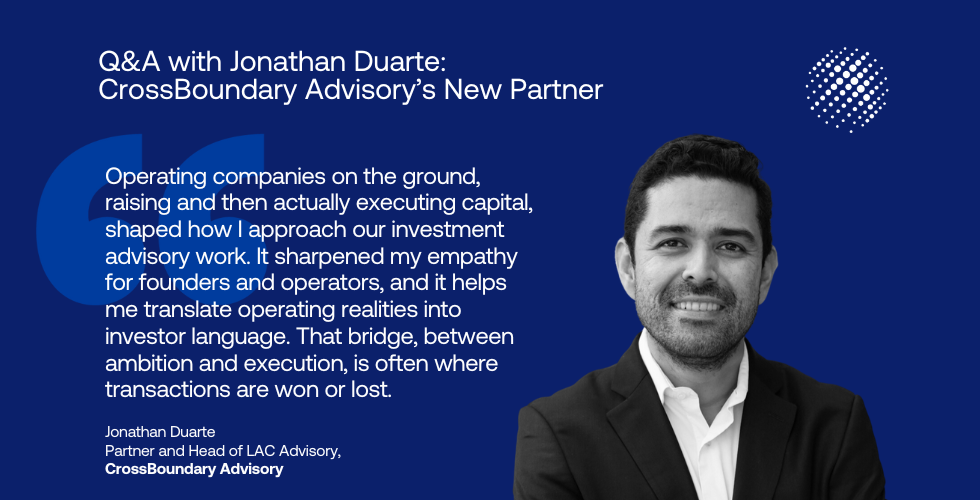
Q&A with Jonathan Duarte, CrossBoundary Advisory’s New Partner
CrossBoundary Advisory recently announced three new partners to lead our growing investment advisory practice.
CrossBoundary Advisory recently announced three new partners to lead our growing investment advisory practice.
Jonathan Duarte, Fanta Conde, and Kirtika Challa will join existing CrossBoundary Advisory Partners in the leadership of the business. Each new partner brings unique expertise and perspectives in the specific geographies and sectors they serve.
We asked Jonathan Duarte to reflect on his career and journey thus far and the opportunities he sees on the horizon for our clients, investors, and CrossBoundary Advisory as a firm.
Q. What was your strategy for building CrossBoundary’s Latin America practice from scratch, and what lessons have you learned about leading a firm to navigate and enter new regional markets?
Jonathan: My approach was simple: get very clear on what CrossBoundary does best, translate those strengths to the region, and spend real time in the market. We treated LAC as CrossBoundary’s first true “no-anchor” expansion—an upfront investment by the firm—so step one was to get laser-clear on our edge, then translate it locally. We listened across the market, shared our investment facilitation and fund advisory playbooks, and focused where our capabilities solved urgent problems; that created a beachhead, because few actors were doing this at our scale.
From there, we stayed close to clients, listened for where our capabilities solved urgent problems, and iterated from there. We now have local presence in seven countries and have worked in about 30 markets across the Latin America and Caribbean (LAC) region.
Q. How do you see the private investment landscape evolving across the seven LAC countries where CrossBoundary now operates?
Jonathan: Private capital is essential, especially in smaller markets like those in the Caribbean and Central America where investor familiarity is limited, and in underserved sub-regions of larger economies (southern Mexico, Brazil’s Amazon, rural Colombia) where perceived risk can be outsized. Our role is to help investors understand the real risks and benefits, structure around them, and support capital deployment where it’s most catalytic.

Q. What makes the LAC region particularly attractive for blended finance structures, and how do you optimize these for both impact and returns?
Jonathan: Blended finance is a powerful transition tool in LAC—especially where perceived risk is high or sectors are still developing. It helps crowd in investors and align expected returns, with the aim of building asset classes that stand commercially on their own. We focus on structures that de-risk early, prove performance, and then taper concessionality as markets mature.
Q. Can you explain how your operating experience as CFO and CEO of regional companies influences your approach to investment advisory work?
Jonathan: Operating companies on the ground, raising and then actually executing capital, shaped how I approach our investment advisory work. It sharpened my empathy for founders and operators, and it helps me translate operating realities into investor language: clear plans, credible numbers, and why the model works in context. That bridge, between ambition and execution, is often where transactions are won or lost.
Q. How has your work with DFIs shaped your understanding of catalytic capital deployment in underserved markets?
Jonathan: DFIs are pivotal partners, but as advisors we need to understand their motivations, cycles, diligence, and capacity constraints. They will take more risk and go earlier than many investors, yet they still target returns and rigorous processes—so bringing the right transactions, with patience on timelines, is critical. Remember: DFIs aren’t philanthropic by default; many also deploy grants/technical assistance, but the core is disciplined investment.
Q. What sectors in Latin America are seeing the most promising private investment activity, and where do you see untapped opportunities?
Jonathan: We’re seeing strong momentum in renewable energy, data centers, resilience infrastructure, logistics, and sustainable agriculture—plus growing interest in nature-based solutions and carbon markets as the region gears up for COP30 later this year. Fintech remains a unifying theme across LAC, with real progress on inclusive financial products.
Q. What advice would you give to international investors looking to deploy capital in Latin American markets for the first time?
Jonathan: Think regionally, not just one country; the portfolio logic across LAC matters. Build context—visit, meet operators, understand how business is done—and take a long-term view: the first investment should open the door to many, sharpening your thesis and results over time. (And yes—call us; our job is to shorten that learning curve.)

Q. You’ve taken on firm-building roles—most notably helping transform CrossBoundary’s DEI committee into an independent, business-embedded function. For teammates considering similar responsibilities, how did that involvement shape your path here, and what did you gain by leaning in?
Jonathan: When I joined, DEI sat within the People team. I helped establish an independent DEI lead role anchored in the business, because our client-facing teams are the ones living those values across markets every day. Making it operator-led kept DEI practical — focused on how diverse teams solve problems better for clients and how we create a place where colleagues can bring their whole selves to work.
Career-wise, stepping into firm-building was a multiplier. Being based in Latin America, the DEI role gave me a true firmwide view, a seat at the table on culture and decision-making, and direct relationships with leaders I didn’t interact with day-to-day. I gained context, influence, and visibility—benefits that ultimately shaped my career trajectory. My message to colleagues: say yes to building the firm. It’s good for our culture and clients, and it’s one of the fastest ways to grow your impact and career at CrossBoundary.



